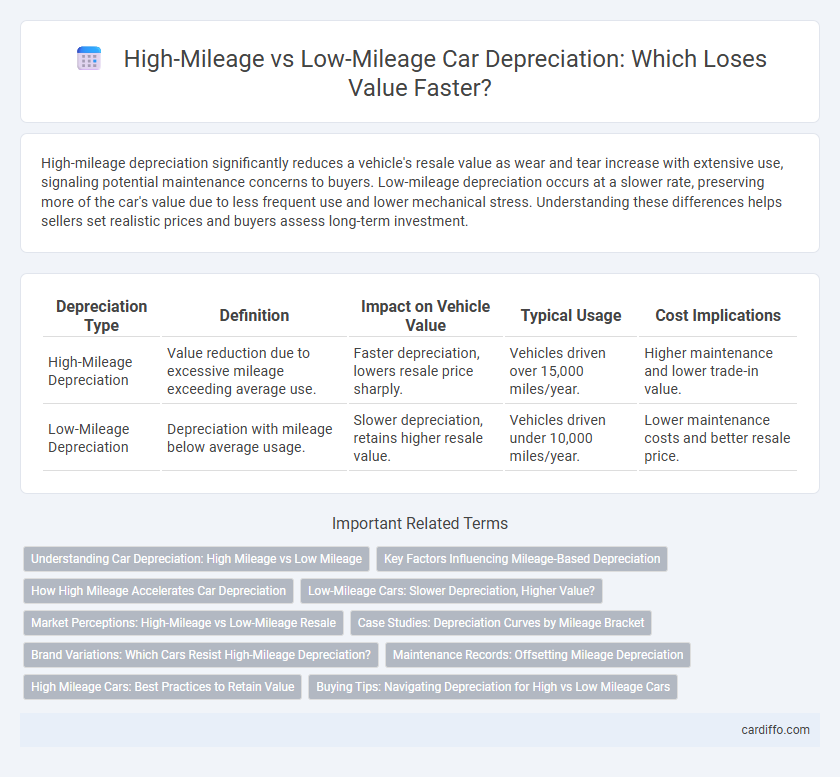High-mileage depreciation significantly reduces a vehicle's resale value as wear and tear increase with extensive use, signaling potential maintenance concerns to buyers. Low-mileage depreciation occurs at a slower rate, preserving more of the car's value due to less frequent use and lower mechanical stress. Understanding these differences helps sellers set realistic prices and buyers assess long-term investment.
Table of Comparison
| Depreciation Type | Definition | Impact on Vehicle Value | Typical Usage | Cost Implications |
|---|---|---|---|---|
| High-Mileage Depreciation | Value reduction due to excessive mileage exceeding average use. | Faster depreciation, lowers resale price sharply. | Vehicles driven over 15,000 miles/year. | Higher maintenance and lower trade-in value. |
| Low-Mileage Depreciation | Depreciation with mileage below average usage. | Slower depreciation, retains higher resale value. | Vehicles driven under 10,000 miles/year. | Lower maintenance costs and better resale price. |
Understanding Car Depreciation: High Mileage vs Low Mileage
High-mileage depreciation typically accelerates a vehicle's value decline due to increased wear and tear, often resulting in lower resale prices compared to low-mileage counterparts. Low-mileage depreciation is generally slower, preserving more of the car's initial value by indicating less extensive use and potentially fewer mechanical issues. Understanding the impact of mileage on depreciation helps buyers and sellers gauge the true market value and expected lifespan of a vehicle.
Key Factors Influencing Mileage-Based Depreciation
High-mileage depreciation accelerates due to increased wear and tear, impacting the vehicle's resale value more significantly than low-mileage counterparts. Key factors influencing mileage-based depreciation include vehicle age, maintenance history, and driving conditions, which collectively determine the rate of value loss. Accurate assessment of these elements enables better prediction of depreciation trends for both high-mileage and low-mileage vehicles.
How High Mileage Accelerates Car Depreciation
High mileage significantly accelerates car depreciation because the increased wear and tear signals reduced remaining lifespan to potential buyers. Vehicles with high mileage often require more frequent maintenance and repairs, leading to higher ownership costs that lower market value. This accelerated depreciation impacts resale prices, making high-mileage cars depreciate faster compared to their low-mileage counterparts.
Low-Mileage Cars: Slower Depreciation, Higher Value?
Low-mileage cars typically experience slower depreciation due to reduced wear and tear, making them more attractive to buyers seeking longevity and reliability. These vehicles retain higher resale value compared to high-mileage counterparts, as mileage is a critical factor in assessing a car's condition and market price. Consequently, low-mileage cars often command premium prices in the used car market, reflecting their preserved value over time.
Market Perceptions: High-Mileage vs Low-Mileage Resale
High-mileage vehicles typically experience accelerated depreciation due to perceived increased wear and tear, leading to lower resale values compared to low-mileage counterparts. Market perceptions often equate high mileage with potential mechanical issues and reduced longevity, driving down demand and price. Conversely, low-mileage cars maintain higher resale values as buyers associate them with better condition and longer remaining lifespan.
Case Studies: Depreciation Curves by Mileage Bracket
Case studies analyzing depreciation curves by mileage bracket reveal that high-mileage vehicles experience a steeper decline in value compared to low-mileage counterparts, with depreciation rates accelerating significantly after 100,000 miles. Data indicate that cars in the 50,000 to 100,000-mile range depreciate moderately, while those exceeding 150,000 miles face the sharpest value drops due to increased maintenance risks and buyer skepticism. These trends highlight the critical impact of mileage thresholds on residual values in used car markets.
Brand Variations: Which Cars Resist High-Mileage Depreciation?
Certain car brands like Toyota, Honda, and Subaru exhibit strong resistance to high-mileage depreciation due to their reputation for reliability and durability. Luxury brands such as Lexus and Mercedes-Benz tend to retain value better with low mileage but can experience steeper depreciation once high-mileage thresholds are crossed. Consumer demand and brand reputation significantly influence how different vehicles depreciate based on mileage variations.
Maintenance Records: Offsetting Mileage Depreciation
Comprehensive maintenance records can significantly offset high-mileage depreciation by demonstrating consistent care and timely repairs, which enhances vehicle value despite increased mileage. Low-mileage vehicles lacking detailed maintenance history may experience unexpected depreciation due to uncertain upkeep. Transparent service documentation reassures buyers, balancing mileage concerns with proven reliability and condition.
High Mileage Cars: Best Practices to Retain Value
High-mileage cars experience faster depreciation due to increased wear and tear, making regular maintenance critical to retaining value. Keeping detailed service records and addressing mechanical issues promptly can significantly slow value loss. Using high-quality replacement parts and avoiding neglect in essential upkeep are proven strategies to preserve resale worth.
Buying Tips: Navigating Depreciation for High vs Low Mileage Cars
High-mileage cars typically depreciate faster due to increased wear and tear, influencing their resale value and insurance costs more significantly than low-mileage vehicles. When buying, prioritize comprehensive vehicle history reports and maintenance records to assess true condition beyond mileage metrics. Low-mileage cars often retain higher value but may require premium investment, so balance mileage, condition, and price to optimize long-term depreciation impact.
High-Mileage Depreciation vs Low-Mileage Depreciation Infographic

 cardiffo.com
cardiffo.com